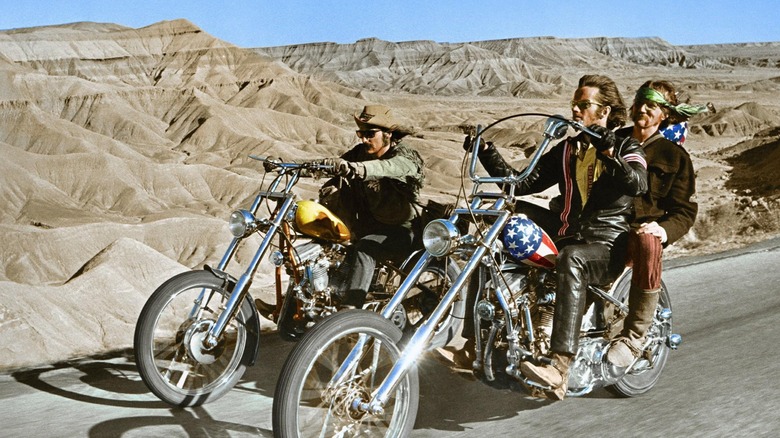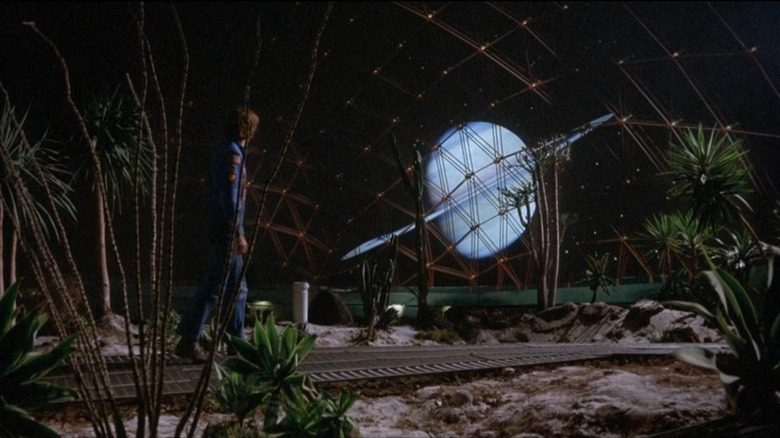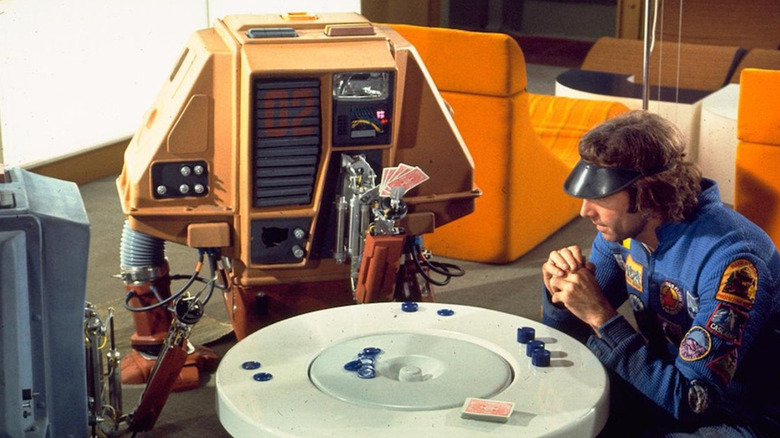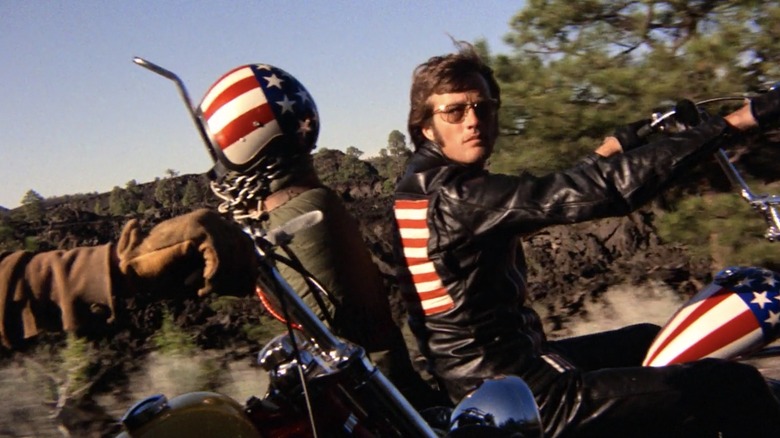How Easy Rider Set The Stage For An Overlooked Douglas Trumbull Sci-Fi Classic
When "Easy Rider" was released into theaters in the summer of 1969, popular culture had already shifted significantly to reflect the spirit of rebellion swelling up among teenagers across the country. Signifying a real change, it was time for the box office and Hollywood to catch up with the tides; "Easy Rider" would go on to gross $60 million around the world. Dennis Hopper and Peter Fonda starred as two free-wheeling bikers from L.A. heading to New Orleans, and "Easy Rider" represented the beginning of counterculture and the death of the sixties, simultaneously. The soundtrack featuring Steppenwolf and The Band was instantly iconic, and the sweeping vistas that Hopper and Fonda rode through helped to define a road trip movie for a new generation. Then, the film's tragic ending served as a reminder that America wasn't really the land of the free, after all.
The surprise success of "Easy Rider" resulted in an influx of cash for Universal Pictures, which was then funneled into multiple youth-centric films, including Peter Fonda's "The Hired Hand" and Dennis Hopper's "The Last Movie," another classic of the time written by Stewart Stern. Milos Foreman was also able to make "Taking Off," about a young girl who runs away to New York City to get out from under the oppressive thumb of her out-of-touch parents. George Lucas' "American Graffiti" was a more retroactive story about what kids were like before counterculture and the horrors of the Vietnam war. Somewhat surprisingly, it became the most successful film out of the bunch.
The other film to get bankrolled was Dalton Trumbull's oft-overlooked sci-fi parable "Silent Running." Set in space, the environmentally conscious meditation on our planet's future was a complete departure, both literally and figuratively, from other counterculture films of the era.
The hippies go to space
The success of "Easy Rider" and "American Graffiti" probably had more to do with the fact that both stories romanticized youth. Wyatt (Fonda) and Billy (Hopper) were riding out into the great unknown, just like Curt (Dreyfuss) in "Graffiti" who wrestled with the decision to stay in his small town or fly off to college on a grand adventure. In both of those films, the unknown is filled with possibilities, whereas the idea of the unknown in "Silent Running" is a much more frightening prospect.
"Silent Running" begins after all botanical life on our planet has been destroyed. Idealistic ecologist Freeman Lowell (Bruce Dern) is tasked with maintaining a vital greenhouse aboard a space station with the hope that his efforts can help feed future generations. That endeavor seems like an essential part of keeping us all alive, but the entire operation is threatened when the order comes in to destroy the greenhouse in favor of carrying cargo and supplies. Lowell and his robot assistants, Huey, Dewey, and Louie, try and save one of the last vestiges of hope that humanity has, at all costs.
That's a pretty dark premise for a science fiction film. Director Douglas Trumbull was a visual effects wizard who worked on "2001: A Space Odyssey" and "Close Encounters of the Third Kind." But aside from the opening sequence, "Silent Running" isn't really that stimulating. It is unique, though, standing as a symbol of the counterculture's idealism reaching outer space. In "Silent Running," the dream of the hippie garden is still possible millions of miles away. "Easy Rider" had perfect timing in 1969 and rode the crest of the sixties wave. Ahead of its time in 1972, we're still catching up to the ideas in "Silent Running" today.
Bruce Dern was the bridge between both films
Bruce Dern's eccentric performance as Lowell in "Silent Running" is subdued at times, and quietly unhinged in others. He's still an idealist to the very end. Even after all hope seems lost, Lowell can still be seen as a far-out representative of counterculture. In 1967, Dern was at the forefront of the hippie movement when he played the acid guru in "The Trip" starring Peter Fonda. Written by Jack Nicholson and featuring Dennis Hopper, "The Trip" was also directed by Roger Corman, who famously took acid for the first time to make his picture more authentic.
Dern guides Fonda's character Paul Groves through his own acid trip, kicking off even more wild experimentation that goes deeper and deeper down the rabbit hole as the story goes on. By the end, they're total burnouts on the verge of insanity, showing just how quickly the dream of the sixties became a nightmare. The cautionary commentary from "The Trip" is absolutely present in "Easy Rider" and "Silent Running," where the counterculture is either a victim of outside forces hellbent on destroying the movement, or how a free love, drug-heavy life could wind up destroying itself from the inside.
Bruce Dern is really the connective tissue between all three films. Starting with Corman and Dern in 1967, Fonda, Hopper, and Nicholson would go on to make "Easy Rider" with Dern and Trumbull waiting to give their own idiosyncratic take on the counterculture's demise with "Silent Running." The environmental message in Trumbull's visionary sci-fi film does still help to carry the flame for some of the hippie ideals that, hopefully, we still value as a culture in 2023.
The Captain America bike vs. Captain America's shield
Today, it's becoming even more of a struggle to get films like "Easy Rider" and "Silent Running" made at all. In the '60s and '70s, people were part of a monoculture that would digest the same kinds of entertainment together. The countless films in the Marvel Cinematic Universe and once-in-a-decade movie experiences like "Avatar: The Way of Water" are the closest we come to that as a culture now.
When "Easy Rider" came out, it was a phenomenon. With our fractured culture today, it's near impossible to again capture that lightning in a bottle. No studio really knows what's going to become a hit. When the counterculture started to actually become the culture, studios were forced to take chances, resulting in filmmakers that were given the chance to make unconventional, thought-provoking movies.
Peter Fonda's Captain America helmet and bike symbolized freedom in a much different (and eventually tragic) way in 1969. With the influx of the MCU, the closest thing we have to that now is Captain America's shield. Yes, it's the same stars and stripes but they represent something entirely different to people, then and now. One stands for possibilities, the other represents protection. When Fonda's Captain America bike is cruising down the highway, it's an anti-government symbol; when Steve Rogers throws up his vibranium shield, it's decidedly pro-government.
The environmental themes in "Silent Running" also mean something different today, now that we're more aware of the planetary effects humans are having on the Earth. The "Avatar" franchise uses those themes in a subtle way, too, they're just using a massive budget to sugarcoat themes of imperialism, deforestation, and ocean rights. "Silent Running" just did it for a million dollars 50 years ago.



